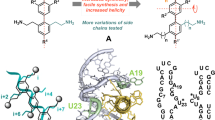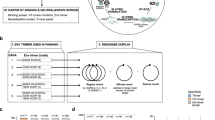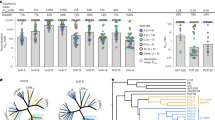Abstract
The trimeric, α-helical coiled-coil core of the HIV-1 gp41 ectodomain is thought to be part of a transient, receptor-triggered intermediate in the refolding of the envelope glycoprotein into a fusion-active conformation. In an effort to discover small organic inhibitors that block gp41 activation, we have generated a biased combinatorial chemical library of non-natural binding elements targeted to the gp41 core. From this library of 61,275 potential ligands, we have identified elements that, when covalently attached to a peptide derived from the gp41 outer-layer α-helix, contribute to the formation of a stable complex with the inner core and to inhibition of gp41-mediated cell fusion.
This is a preview of subscription content, access via your institution
Access options
Subscribe to this journal
Receive 12 print issues and online access
$189.00 per year
only $15.75 per issue
Buy this article
- Purchase on Springer Link
- Instant access to full article PDF
Prices may be subject to local taxes which are calculated during checkout







Similar content being viewed by others
References
Dimitrov, D.S. How do viruses enter cells? The HIV coreceptors teach us a lesson of complexity. Cell 91, 721–730 (1997).
Sattentau, Q.J. & Moore, J.P. Conformational changes induced in the human immunodeficiency virus envelope glycoprotein by soluble CD4 binding. J. Exp. Med. 174, 407–415 (1991).
Sattentau, Q.J. & Moore, J.P. Conformational changes induced in the envelope glycoproteins of the human and simian immunodeficiency viruses by soluble receptor binding. J. Virol. 67, 7383–7393 (1993).
Trkola, A. et al. CD4-dependent, antibody-sensitive interactions between HIV-1 and its co-receptor CCR-5. Nature 384, 184 –187 (1996).
Wu, L. et al. CD4-induced interaction of primary HIV-1 gp120 glycoproteins with the chemokine receptor CCR-5. Nature 384, 179–183 (1996).
Littman, D.R. Chemokine receptors: Keys to AIDS pathogenesis? Cell 93, 677–680 (1998).
Sullivan, N., et al. CD4-induced conformational changes in the human immunodeficiency virus type 1 gp120 glycoprotein: consequences for virus entry and neutralization. J. Virol. 72, 4694–4703 (1998).
Chan, D.C., Fass, D., Berger, J.M. & Kim, P.S. Core structure of gp41 from the HIV envelope glycoprotein. Cell 89, 263–273 (1997).
Weissenhorn, W., Dessen, A., Harrison, S.C., Skehel, J.J. & Wiley, D.C. Atomic structure of the ectodomain from HIV-1 gp41. Nature 387, 426– 430 (1997).
Tan, K., Liu, J.-H., Wang, J.-H., Shen, S. & Lu, M. Atomic structure of a thermostable subdomain of HIV-1 gp41. Proc. Natl. Acad. Sci. USA 94, 12303–12308 (1997).
Bullough, P.A., Hughson, F.M., Skehel, J.J. & Wiley, D.C. Structure of influenza haemaglutinin at the pH of membrane fusion. Nature 371, 37–43 ( 1994).
Joshi, S.B., Dutch, R.E. & Lamb, R.A. A core trimer of the paramyxovirus fusion protein: parallels to influenza virus hemagglutinin and HIV-1 gp41. Virology 248, 20–34 (1998).
Dutch, R.E., Leser, G.P. & Lamb, R.A. Paramyxovirus fusion protein: characterization of the core trimer, a rod-shaped complex with helices in anti-parallel orientation. Virology 254, 147–159 (1999).
Baker, K.A., Dutch, R.E., Lamb, R.A. & Jardetzky, T.S. Structural basis for paramyxovirus-mediated membrane fusion. Mol. Cell 3, 309–319 (1999).
Weissenhorn, W., Carfí, A., Lee, K.-H., Skehel, J.J. & Wiley, D.C. Crystal structure of the Ebola virus membrane fusion, GP2, from the envelope glycoprotein ectodomain. Mol. Cell 2, 605–616 ( 1998).
Malashkevich, V.N., et al. Core structure of the envelope glycoprotein GP2 from Ebola virus at 1.9A resolution. Proc. Natl. Acad. Sci. USA 96, 2662–2667 (1999).
Fass, D., Harrison, S.C. & Kim, P.S. Retrovirus envelope domain at 1.7 angstrom resolution. Nature Struct. Biol. 3, 465– 469 (1996).
Center, R.J., et al. Crystallization of a trimeric human T cell leukemia virus type 1 gp21 ectodomain fragment as a chimera with maltose-binding protein. Protein Sci. 7, 1612–1619 (1998).
Kobe, B., Center, R.J., Kemp, B.E. & Poumbourios, P. Crystal structure of human T cell leukemia virus type 1 gp21 ectodomain crystallized as a maltose-binding protein chimera reveals structural evolution of retroviral transmembrane proteins. Proc. Natl. Acad. Sci. USA 96, 4319– 4324 (1999).
Caffrey, M., et al. Three-dimensional solution structure of the 44kDa ectodomain of SIV gp41. EMBO J. 17, 4572– 4584 (1998).
Malashkevich, V.N., Chan, D.C., Chutkowski, C.T. & Kim, P.S. Crystal structure of the simian immunodeficiency virus (SIV) gp41 core: conserved helical interactions underlie the broad inhibitory activity of gp41 peptides. Proc. Natl. Acad. Sci. USA 95, 9134– 9139 (1998).
Skehel, J.J. & Wiley, D.C. Coiled coils in both intracellular vesicle and viral membrane fusion. Cell 95, 871–874 (1998).
Hughson, F.M. Enveloped viruses: A common mode of membrane fusion? Current Biology 7, 565–569 ( 1997).
Daniels, R.S. et al. Fusion mutants of influenza virus hemagglutinin glycoprotein. Cell 40, 431–439 (1985).
Bodian, D.L. et al. Inhibition of the fusion-inducing conformational change of influenza hemagglutinin by benzoquinones and hydroquinones. Biochemistry 32, 2967–2978 ( 1993).
Hoffman, L.R., Kuntz, I.D. & White, J.M. Structure-based identification of an inducer of low-pH conformational change in influenza virus hemagglutinin: irreversible inhibition of infectivity. J. Virol. 71, 8808– 8820 (1997).
Wild, C., Oas, T., McDanal, C., Bolognesi, D. & Matthews, T. A synthetic peptide inhibitor of human immunodeficiency virus replication: correlation between solution structure and viral inhibition. Proc. Natl. Acad. Sci. USA 89, 10537– 10541 (1992).
Wild, C.T., Shugars, D.C., Greenwell, T.K., McDanal, C.B. & Matthews, T.J. Peptides corresponding to a predictive α-helical domain of human immunodeficiency virus type 1 gp41 are potent inhibitors of virus infection. Proc. Natl. Acad. Sci. USA 91, 9770–9774 (1994).
Gallaher, W.R., Ball, J.M., Garry, R.F., Griffin, M.C. & Montelaro, R.C. A general model for the transmembrane proteins of HIV and other retroviruses. AIDS Res. Human Retroviruses 5, 431–440 (1989).
Kilby, J.M. et al. Potent suppression of HIV-1 replication in humans by T-20, a peptide inhibitor of gp41-mediated virus entry. Nature Med. 4, 1302–1307 (1998).
Dubay, J.W., Roberts, S.J., Brody, B. & Hunter, E. Mutations in the leucine zipper of the human immunodeficiency virus type 1 transmembrane glycoprotein affect fusion and infectivity. J. Virol. 66, 4748–4756 (1992).
Weng, Y. & Weiss, C.D. Mutational analysis of residues in the coiled-coil domain of human immunodeficiency virus type 1 transmembrane protein gp41. J. Virol. 72, 9676– 9682 (1998).
Chan, D.C., Chutkoski, C.T. & Kim, P.S. Evidence that a prominent cavity in the coiled coil of HIV type 1 gp41 is an attractive drug target. Proc. Natl. Acad. Sci. USA 95, 15613–15617 (1998).
Combs, A.P., et al. Protein structure-based combinatorial chemistry: discovery of non-peptide binding elements to Src SH3 domain. J. Am. Chem. Soc. 118, 287–288 ( 1996).
Feng, S., Kapoor, T.M., Shirai, F., Combs, A.P. & Schreiber, S.L. Molecular basis for the binding of SH3 ligands with non-peptide elements by combinatorial synthesis. Chem. Biol. 3, 661–670 (1996).
Lam, K.S., Lebl, M. & Krchnák, V. The one bead-one-compound combinational library method. Chem. Rev. 97, 411–448 (1997).
Erb. E., Janda, K.D. & Brenner, S. Recursive deconvolution of combinational chemical libraries. Proc. Natl. Acad. Sci. USA 91, 11422– 11426 (1997).
Lu, M., Blacklow, S.C. & Kim, P.S. A trimeric structural domain of the HIV-1 transmembrane glycoprotein. Nature Struct. Biol. 2, 1075 –1082 (1995).
Lawless, M.K. et al. HIV-1 membrane fusion mechanism: structural studies of the interactions between biologically-active peptides from gp41. Biochemistry 35, 13697–13708 ( 1996).
Muñoz-Barroso, I., Durell, S., Sakaguchi, K., Appella, E. & Blumenthal, R. Dilation of the human immunodeficiency virus-1 envelope glycoprotein fusion pore revealed by the inhibitory action of a synthetic peptide from gp41. J. Cell Biol. 140 , 315–323 (1998).
Furuta, R.A., Wild, C.T., Weng, Y. & Weiss, C.D. Capture of an early fusion-active conformation of HIV-1 gp41. Nature Struc. Biol. 5, 276–279 ( 1998).
Blacklow, S.C., Lu, M. & Kim, P.S. A trimeric subdomain of the simian immunodeficiency virus envelope glycoprotein. Biochemistry 34, 14955– 14962 (1995).
Weissenhorn, W., et al. Assembly of a rod-shaped chimera of a trimeric GCN4 zipper and the HIV-1 gp41 ectodomain expressed in Escherichia coli. Proc. Natl. Acad. Sci. USA 94, 6065–6069 (1997).
Rimsky, L.T., Shugars, D.C. & Matthews, T.J. Determinants of human immunodeficiency virus type 1 resistance to gp41-derived inhibitory peptides. J. Virol. 72, 986–993 (1998).
Franke, R.R., Sakmar, T.P., Oprian, D.D. & Khorana, H.G. A single amino acid substitution in rhodopsin (lysine 248-leucine) prevents activation of transducin. J. Biol. Chem. 263, 2119–2122 (1988).
Nussbaum, O., Broder, C.C. & Berger, E.A. Fusogenic mechanisms of enveloped-virus glycoproteins analyzed by a novel recombinant vaccinia virus-based assay quantitating cell fusion-dependent reporter gene activation. J. Virol. 68, 5411–5422 (1994).
Carson, M. & Bugg, C.E. Algorithm for ribbon models of proteins. J. Mol. Graph. 4, 121– 122 (1986).
Acknowledgements
We thank N. Sinitskaya for technical assistance. M.F. acknowledges a fellowship from the Ministry of Education (Spain). The work was supported by NIH grants to D.O., D.C.W., and S.C.H. S.L.S., D.C.W., and S.C.H. are Investigators in the HHMI.
Author information
Authors and Affiliations
Corresponding author
Rights and permissions
About this article
Cite this article
Ferrer, M., Kapoor, T., Strassmaier, T. et al. Selection of gp41-mediated HIV-1 cell entry inhibitors from biased combinatorial libraries of non-natural binding elements. Nat Struct Mol Biol 6, 953–960 (1999). https://doi.org/10.1038/13324
Received:
Accepted:
Issue Date:
DOI: https://doi.org/10.1038/13324
This article is cited by
-
In-solution enrichment identifies peptide inhibitors of protein–protein interactions
Nature Chemical Biology (2019)
-
N-cap helix nucleation: methods and their applications
Science China Chemistry (2017)
-
Site-specific Isopeptide Bridge Tethering of Chimeric gp41 N-terminal Heptad Repeat Helical Trimers for the Treatment of HIV-1 Infection
Scientific Reports (2016)
-
Structural basis for HIV-1 neutralization by a gp41 fusion intermediate–directed antibody
Nature Structural & Molecular Biology (2006)
-
Restraining the conformation of HIV-1 gp120 by removing a flexible loop
The EMBO Journal (2006)



